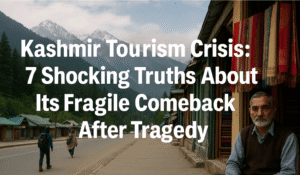Kashmir Tourism Crisis: 7 Shocking Truths About Its Fragile Comeback After Tragedy
Kashmir’s tourism industry, once a thriving lifeline, is struggling to recover after a tragic attack that claimed 26 lives in Pahalgam. Local businesses, like those of shopkeeper Rafi Ahmed, face severe economic hardship, with cancellations soaring by up to 90%. While the region had seen a resurgence in tourism post-2019, this incident has shattered that fragile hope. Tourists are torn between fear and empathy, as the attack raises anxiety over regional tensions.
The broader impact extends to stalled investments and disrupted daily life, further undermining Kashmir’s recovery. The local community, however, remains resilient, with individuals like Rafi Ahmed continuing to open their shops in quiet defiance. Kashmir’s future hinges on more than just security; it requires rebuilding trust, understanding the complexities of its geopolitical challenges, and healing from the deep human scars left by violence.

Kashmir Tourism Crisis: 7 Shocking Truths About Its Fragile Comeback After Tragedy
Nestled in the Himalayan foothills, Pahalgam’s meadows and rivers once drew travelers seeking serenity. Today, the town embodies a paradox—a fragile hope for renewal shadowed by grief and geopolitical strife. A week after militants killed 26 tourists in nearby Baisaran, the “Switzerland of India” grapples with the aftermath of an attack that has shaken its economic lifeline and tested its resilience.
A Community’s Struggle to Rebuild
Shopkeepers like Rafi Ahmed, who sells handwoven shawls, voice quiet desperation. “Three days without a single sale,” he says, gesturing to empty streets now dotted with a handful of returning tourists. For locals, tourism isn’t just an industry—it’s survival. Hotels, drivers, and artisans depend on visitors drawn to Kashmir’s alpine beauty. Yet cancellations surged to 80–90% after the attack, Mumbai tour operator Abhishek Sansare confirms. Some travelers, like Akshay Solanki from Mumbai, stayed only because flight costs spiked. Others, reassured by locals and tightened security, linger cautiously.
The attack’s timing cuts deep. Indian officials had touted Kashmir’s post-2019 “peace dividend” after autonomy was revoked, citing record tourism numbers. Now, that narrative collides with reality. “This is a blot on us,” admits local politician Rafi Ahmed Meer, urging outsiders to remember how Kashmiris rushed to aid victims—a plea for solidarity amid stigma.
Tourists Torn Between Fear and Empathy
For visitors, the dilemma is visceral. Social media fills with images of families posing by riversides, juxtaposed with bullet-ridden buses. Bollywood actor Atul Kulkarni, who visited post-attack, argues defiance: “Answer violence by coming in larger numbers.” Yet confusion lingers. “People think war is looming,” Sansare explains, reflecting tourists’ anxiety over India-Pakistan tensions.
The human toll transcends economics. A newlywed naval officer’s widow, children witnessing parents slain, and families forever scarred by their “holiday” weigh heavily on Kashmir’s conscience. “What could I say to them?” asks Jammu and Kashmir’s tourism minister, Omar Abdullah, his apology echoing a community’s guilt.
Ripple Effects Beyond Tourism
The fallout extends to stalled investments and infrastructure. The launch of Kashmir’s landmark rail bridge—a symbol of connectivity—now hangs in limbo. Ubair Shah, who runs a cold storage facility in Pulwama, fears investors will retreat: “Confidence is shattered.” Meanwhile, security forces comb villages, razing homes of alleged militants, further destabilizing daily life.
A Path Forward?
Kashmir’s recovery hinges on nuanced truths. While violence has ebbed since the 1990s insurgency, sporadic attacks like this one expose enduring vulnerabilities. Locals emphasize their role as victims, not perpetrators, of cross-border strife. For tourists, the choice to visit becomes an act of empathy—or a risk too great.
As Pahalgam’s selfie spots slowly repopulate, the crisis underscores a broader lesson: Stability cannot be measured by visitor numbers alone. It demands addressing root tensions while honoring those who, like Rafi Ahmed, keep their shops open—not just for income, but as quiet acts of defiance.
In the end, Kashmir’s story is one of fragile beauty and human tenacity. Whether it can reclaim its place as a haven for travelers depends on more than security checkpoints; it requires rebuilding trust, both within and beyond its valleys. The world watches, hoping resilience outlasts fear.
You must be logged in to post a comment.